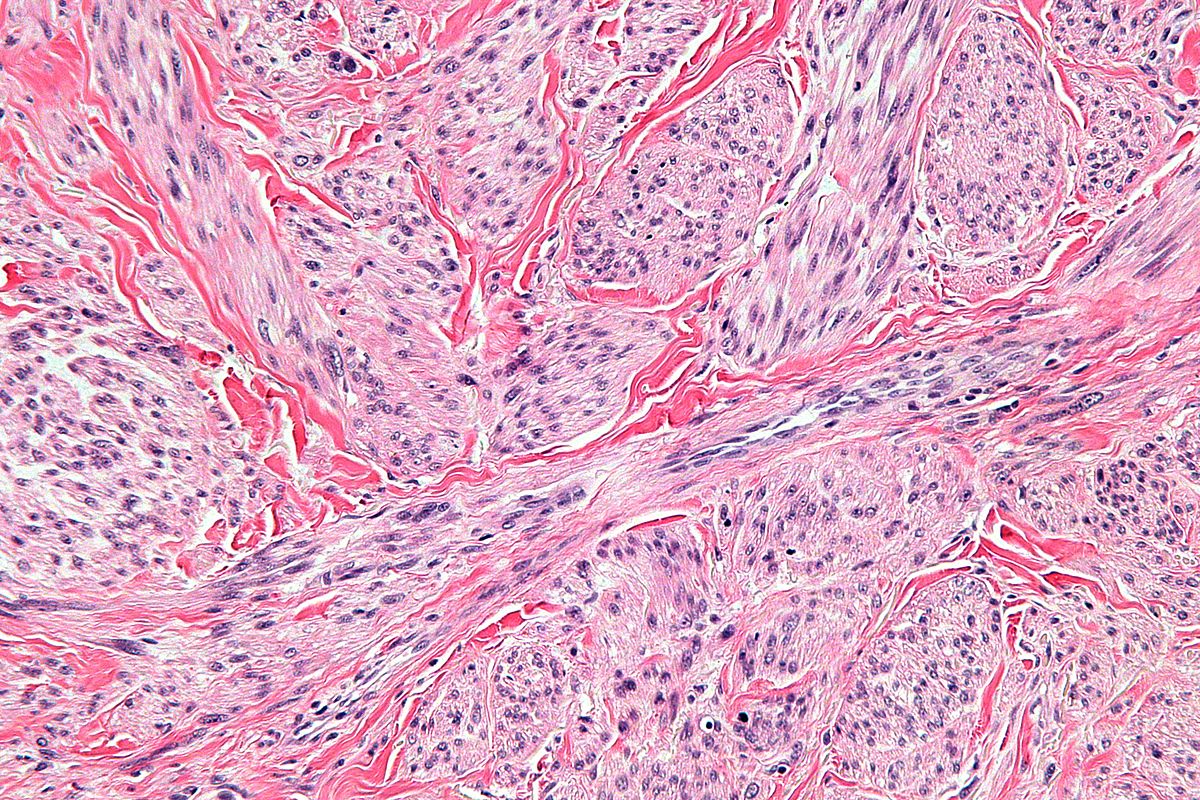Leiomyosarcoma pathophysiology: Difference between revisions
Nima Nasiri (talk | contribs) No edit summary |
Nima Nasiri (talk | contribs) |
||
| (9 intermediate revisions by the same user not shown) | |||
| Line 1: | Line 1: | ||
__NOTOC__ | __NOTOC__ | ||
{{Leiomyosarcoma}} | {{Leiomyosarcoma}} | ||
{{CMG}}{{AE}}{{Nnasiri | {{CMG}}{{AE}} {{Nnasiri}} | ||
==Overview== | ==Overview== | ||
Leiomyosarcoma is a rare cancerous tumor that consists of smooth | Leiomyosarcoma is a rare cancerous tumor that consists of [[smooth muscle cells]]. It is an aggressive type of [[sarcoma]], spreads through the blood stream and can affect the [[lungs]], [[liver]], [[blood vessels]], or any other [[soft tissue]] in the body. The exact cause of leiomyosarcoma is not known, although [[genetic]] and [[environmental factor]]<nowiki/>s appear to be involved.It is most often found in the [[uterus]] or [[abdomen]]. | ||
==Pathophysiology== | ==Pathophysiology== | ||
The pathogenesis of [[leimyosarcoma]] is characterized by malignant smooth muscle neoplasm that can appear in any site in the body but most commonly found in the | The [[pathogenesis]] of [[leimyosarcoma]] is characterized by malignant [[smooth muscle]] neoplasm that can appear in any site in the body but most commonly found in the uterus, [[small intestine]] and retro [[peritoneum]].<ref name="pmid20430913">Arnold LM, Burman SD, O-Yurvati AH (2010) [https://www.ncbi.nlm.nih.gov/entrez/eutils/elink.fcgi?dbfrom=pubmed&retmode=ref&cmd=prlinks&id=20430913 Diagnosis and management of primary pulmonary leiomyosarcoma.] ''J Am Osteopath Assoc'' 110 (4):244-6. PMID: [https://pubmed.gov/20430913 20430913]</ref> | ||
=== Gross Pathology === | === Gross Pathology === | ||
On gross pathology, leiomyosarcoma | On [[gross pathology]], leiomyosarcoma have the following characteristics:<ref name="WilkinsonRollason2001">{{cite journal|last1=Wilkinson|first1=N|last2=Rollason|first2=T P|title=Recent advances in the pathology of smooth muscle tumours of the uterus|journal=Histopathology|volume=39|issue=4|year=2001|pages=331–341|issn=0309-0167|doi=10.1046/j.1365-2559.2001.01300.x}}</ref> | ||
* Large, solitary, poorly circumscribed masses with average size of 10 cm. | |||
* Fleshy colorful cut surface with areas of [[hemorrhage]] or [[necrosis]]. | |||
=== Microscopic Pathology === | |||
On microscopic pathological analysis, leimyosarvoma can have following characteristic, these are include: <ref name="pmid81790712">{{cite journal |vauthors=Bell SW, Kempson RL, Hendrickson MR |title=Problematic uterine smooth muscle neoplasms. A clinicopathologic study of 213 cases |journal=Am. J. Surg. Pathol. |volume=18 |issue=6 |pages=535–58 |date=June 1994 |pmid=8179071 |doi= |url=}}</ref> | |||
* Prominent cellular [[atypia]], | |||
* Nuclear [[atypia]], including nuclear [[pleomorphism]], hyperchromatism, irregularity in [[nuclear]] membranes, high [[nuclear]] size, and prominent [[nucleoli]]. | |||
* Abundant [[mitoses]], [[mitotic index]] higher than10 or more per 10 high-power fields. | |||
* Areas of [[coagulative necrosis]] (Tumor cell [[necrosis]]), always accompanied by [[Cytological|cytologic]] [[atypia]] and brisk [[mitotic]] activity. | |||
[[File:Cutaneous leiomyosarcoma - high mag.jpg|400px|thumb|left|Leimoyosarcoma H&E[https://commons.wikimedia.org/wiki/File:Cutaneous_leiomyosarcoma_-_high_mag.jpg#filehistoryhttps://commons.wikimedia.org/wiki/User:Nephron]]]<br style="clear:left" /> | |||
===Microscopic Pathology=== | ===Microscopic Pathology=== | ||
Latest revision as of 19:31, 8 March 2019
|
Leiomyosarcoma Microchapters |
|
Diagnosis |
|---|
|
Treatment |
|
Case Studies |
|
Leiomyosarcoma pathophysiology On the Web |
|
American Roentgen Ray Society Images of Leiomyosarcoma pathophysiology |
|
Risk calculators and risk factors for Leiomyosarcoma pathophysiology |
Editor-In-Chief: C. Michael Gibson, M.S., M.D. [2]Associate Editor(s)-in-Chief: Nima Nasiri, M.D.[3]
Overview
Leiomyosarcoma is a rare cancerous tumor that consists of smooth muscle cells. It is an aggressive type of sarcoma, spreads through the blood stream and can affect the lungs, liver, blood vessels, or any other soft tissue in the body. The exact cause of leiomyosarcoma is not known, although genetic and environmental factors appear to be involved.It is most often found in the uterus or abdomen.
Pathophysiology
The pathogenesis of leimyosarcoma is characterized by malignant smooth muscle neoplasm that can appear in any site in the body but most commonly found in the uterus, small intestine and retro peritoneum.[1]
Gross Pathology
On gross pathology, leiomyosarcoma have the following characteristics:[2]
- Large, solitary, poorly circumscribed masses with average size of 10 cm.
- Fleshy colorful cut surface with areas of hemorrhage or necrosis.
Microscopic Pathology
On microscopic pathological analysis, leimyosarvoma can have following characteristic, these are include: [3]
- Prominent cellular atypia,
- Nuclear atypia, including nuclear pleomorphism, hyperchromatism, irregularity in nuclear membranes, high nuclear size, and prominent nucleoli.
- Abundant mitoses, mitotic index higher than10 or more per 10 high-power fields.
- Areas of coagulative necrosis (Tumor cell necrosis), always accompanied by cytologic atypia and brisk mitotic activity.

Microscopic Pathology
{{#ev:youtube|6OkMCMXucqw}}
References
- ↑ Arnold LM, Burman SD, O-Yurvati AH (2010) Diagnosis and management of primary pulmonary leiomyosarcoma. J Am Osteopath Assoc 110 (4):244-6. PMID: 20430913
- ↑ Wilkinson, N; Rollason, T P (2001). "Recent advances in the pathology of smooth muscle tumours of the uterus". Histopathology. 39 (4): 331–341. doi:10.1046/j.1365-2559.2001.01300.x. ISSN 0309-0167.
- ↑ Bell SW, Kempson RL, Hendrickson MR (June 1994). "Problematic uterine smooth muscle neoplasms. A clinicopathologic study of 213 cases". Am. J. Surg. Pathol. 18 (6): 535–58. PMID 8179071.